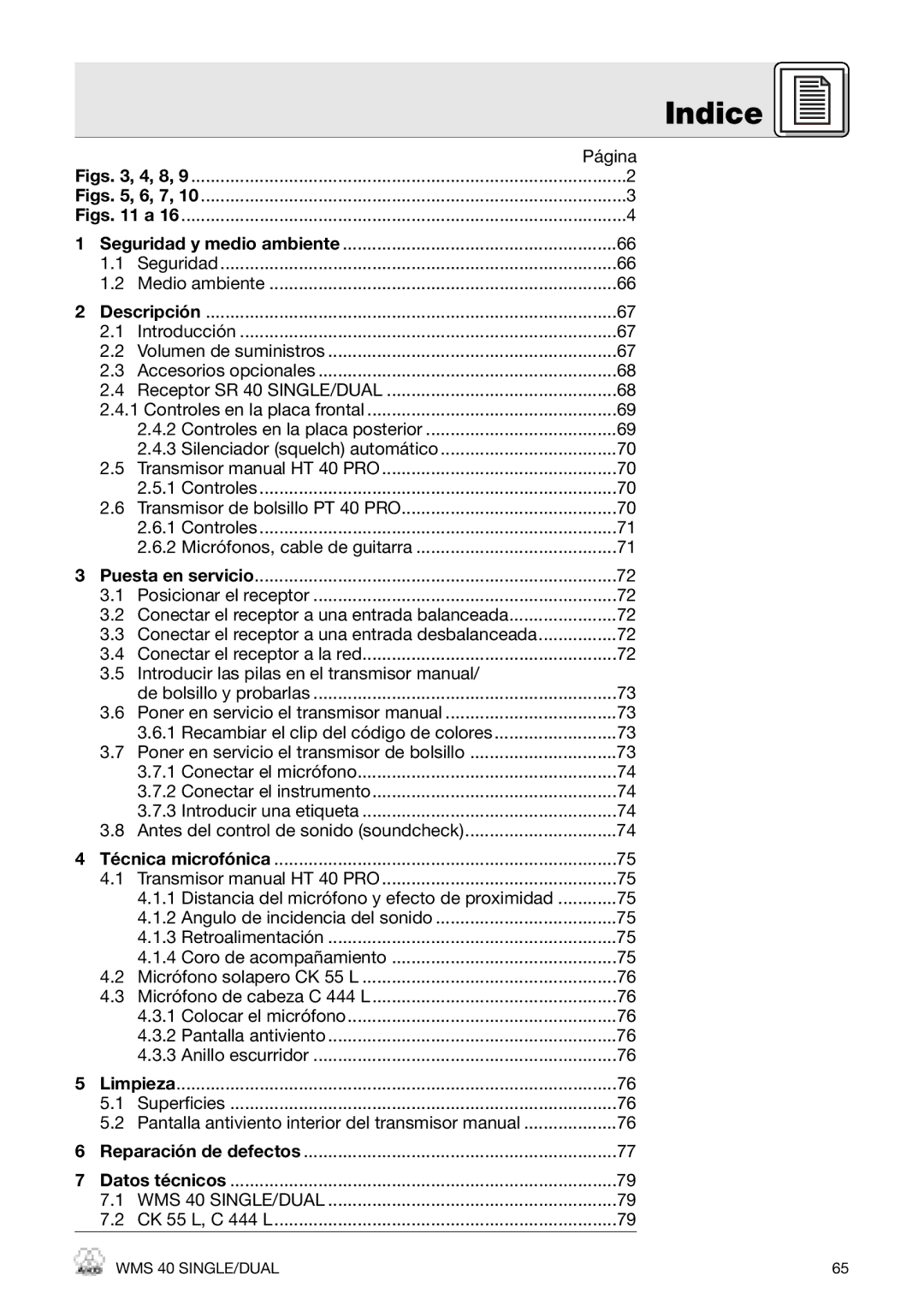WMS 40 SINGLE/DUAL
WMS 40 PRO SINGLE/DUAL
21a
WMS 40 SINGLE/DUAL
Seite
Inhaltsverzeichnis
Etikett einlegen
Headset-Mikrofon C 444 L
Sicherheit und Umwelt
Empfänger SR 40 Dual Schwarz
Beschreibung
Taschensender PT 40 PRO
Empfänger SR
Sets mit Zweikanal
Taschensender PT 40 PRO Handsender HT 40 PRO
Kabel MKG L Rent Empfänger SR 40 Dual
Automatischer
An der Rückseite
Squelch
Handsender
Batteriefachdeckel Siehe Kapitel
Mikrofone
Batteriefachdeckel mit integriertem Schraubenzieher 21a
Gangsbuchse des PT 40 PRO anschließen
Gitarrenkabel
Inbetriebnahme
Hinweis Handsender in Betrieb nehmen
Batterien in den Hand-/Taschen- sender einlegen und testen
Siehe auch Kapitel 4 Mikrofontechnik
Farbcode-Clip tauschen
Inbetriebnahme
Mikrofontechnik
Fon C 444 L
Reinigung
Rauschen, Krachen
Fehlerbehebung
Fehler Mögliche Ursache Behebung
Antennenposition Empfänger an einer anderen
GAIN-Regler soweit zurück
Stelle aufstellen. Falls Dro
Pouts bestehen bleiben, kri
Abmessungen Nettogewicht
Technische Daten
710 865 MHz 40 20.000 Hz ±15 kHz Typ ,8% Typ dBA
CK 55 L, C 444 L
Table of Contents
FCC Statement
Safety and Environment
Single receiver
Description
Kits with SR
Kits with SR 40 Dual receiver
Accessories
Optional
Receivers
Receiver while the transmitter is off
Rear panel
Battery compartment lid Refer to section
LED lit green Battery is OK
HT 40 PRO
PT 40 PRO Body- pack Transmitter
Battery compartment lid with integrated screwdriver 21a
Connecting the Receiver to an Un- balanced Input Refer to on
Setting Up
To the polarity marks
Pack Transmitters
Round
Replacing the Color Code Clip
Connecting a
AKG warranty scheme
Connecting an
Microphone
Microphone tiepin
Microphon Technique
Cleaning
Distortion
Troubleshooting
Problem Possible Cause Remedy
Specifications
Mise en place et test des piles de l’émetteur à main
Table des matierès
Sécurité et environnement
PRO
Emetteur de poche PT
Modèles équipés du récepteur à deux canaux SR 40 Dual
Accessoires
Optionnels
Récepteur
Demeure sur la face avant
Commandes
Votre amplificateur
De la face arrière
Automatique des
3 Atténuation
Bruits de fond
Emetteur à main
CK 55 L 417 L 420 L 444 L
Mise en service
Poche et contrôle de
’émetteur à main/de
La charge
Du clip de couleur
’un instrument de
Raccordement d’un microphone Voir la de la
Musique
Insertion d’une
’accompagnement crophone
Technique du microphone
Nettoyage
Défaut Cause possible Remède
’autres installations sans Ou défectueux hors tension
Dépannage
Antennes Place. Si les décrochages
Position de l’antenne des Changer le récepteur de
’action
Persistent, marquer les en Droits critiques et les éviter
Mini XLR à 3 broches Noir satiné 130 ø Sans connecteur
Caractéristiques techniques
Mini XLR à 3 broches Noir satiné X 22 L Sans câble
Figg , 4, 8
Indice
Pagina
Figg , 6, 7
Sicurezza ed ambiente
Introduzione
Descrizione
Dotazione
Ad un canale SR
Instrumental SET Dual 2 Trasmettitori da tasca
Elementi di comando sul retro del ricevitore SR 40 Dual
Comando sul retro
Descrizione
Avvertenza
Il LED è acceso di verde Batteria o.k
Microfoni
CK 55 L Cavo per chitarra 417 L 420 L 444 L
Il ricevitore
Messa in esercizio
Come
Trasmettitore a
Batterie nel
Mano/da tasca e
Come testarle
Come colle- gare uno strumento
Tecnica microfonica
Microfono headset C 444 L
Pulizia
Popping interno del
Rio
Impianti senza filo, da tv, ra
Guida alla soluzione di problemi
Problema Possibile causa Rimedio
Critici ed evitarli
Delle antenne Un altro punto. Se i dropout
Persistono, marcare i punti
Dati tecnici
CK 55 L, C 444 L
Introducir las pilas en el transmisor manual
Página
Seguridad y medio ambiente
Descripción
Opcionales o Dual
Instrumental SET Dual 2 Transmisores de bolsillo
Controles en
Descripción
Controles Véase en la página
El LED se ilumina de verde la pila está en orden
Nota
Tapa de la caja de pilas con destornillador integrado 21a
Posicionar el
Puesta en servicio
Receptor
Nual de Instrucciones del RMU 40 PRO
Véase también el Capítulo 4 Técnica microfónica
Nota Poner en servicio el trans- misor manual
Recambiar el clip del código de colores
Véase en la página
El LED AF Clip 5 en el receptor
En on
Microfónica
Técnica microfónica
Viento interior del
Limpieza
Micrófono de cabeza C 444 L
Defecto Posible causa Reparación
Reparación de defectos
Des en on
Equipos inalámbricos, tele Turbadores o defectuosos o
Antenas Lugar. Si siguen existiendo
Muy bajo
Las pérdidas de sonido, de
Ben marcarse y evitarse los
Mini-XLR 3 polos Negro opaco X 22 mm Sin cable
Especificaciones técnicas
Tiempo de operación Tip h con pila de
Índice
Segurança e meio ambiente
Folha adicional Manual Supplement
Apresentação
Acessórios opcionais Receptor
Sets com receptor de dois canais SR 40 Dual
Comando
De mixagem ou do seu amplificador
Sinal recebido sobrecarrega a seção de áudio do receptor
Nal de recepção. O SR 40 Dual assim como o SR 40 Single pos
Mático
Squelch auto
Emissor de mão
Elementos de
Compartimento de pilhas com chave de fendas integrada 21a
Importante
Operação
Conectar o
Receptor a uma
De mão
Mão/de bolso e
Instrumento
Microfone
Conectar um
Técnica de microfone
Que maior de
Coro
Acompanhante
Dos ponteiros do relógio
Limpeza
Remova a tela antivento peça de espuma da tampa de grades
Lave a tela antivento numa lixívia de sabão muito diluída
Problema Causa possível
Resolver problemas
Antenas Outro lugar. Caso as inte
Posição da antena das Posicionar o receptor num
Rrupções de som conti
Nuem, marcar os lugares
Especificações
AKG ACOUSTICS, U.S

